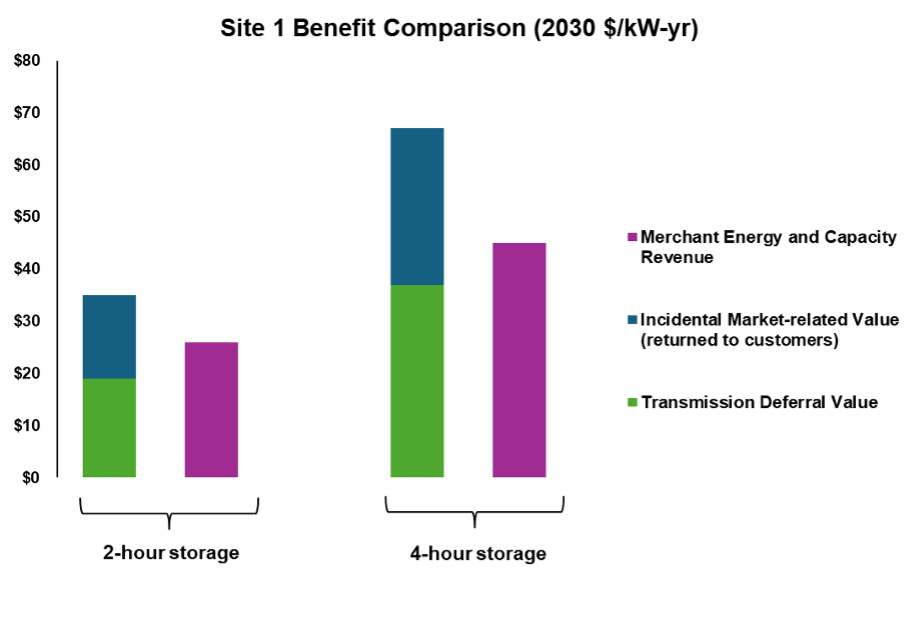
In June of 2024, the New York State Public Service Commission (PSC) approved the Energy Storage Order (the Order), an ambitious storage target of 6 gigawatts (GW) statewide by 2030, representing approximately 20% of the state’s peak load. It doubles New York’s previous energy storage goal, and is designed to help the state to reach its commitment to a zero-emission electricity system by 2040 as laid out in the Climate Leadership and Community Protection Act (CLCPA) of 2019.
The Order outlines situations in which utility-owned storage (UOS) may be considered, such as when the storage device meets a clear system need and an asset owned and operated by a third party is inadequate to meet that need. The PSC directed utilities within New York to examine “the non-market transmission and distribution services that energy storage projects can provide.” E3, with funding from National Grid, drafted a report exploring the use cases for utility-owned storage in New York State, which was cited in National Grid’s filing to the Commission on October 29. E3 appreciates the review and feedback in the creation of this report from all National Grid contributors, as well as the various utilities and subject matter experts that were interviewed in support of this report; however, the final report conclusions and analysis reflect only those of the E3 Study Team.
Having storage devices situated on the transmission grid is valuable in addressing challenges in the transition toward a zero-emission electricity system. As intermittent resources become more prevalent and firm dispatchable resources decline, increasing the transfer capacity of the transmission network and enhancing system flexibility will become increasingly important. Utility-owned storage can provide many of the same benefits as traditional wires solutions, such as congestion management, renewable curtailment reduction, and grid stability services. Storage assets also may be able to be developed on a shorter timeframe, have a smaller physical footprint, and can be added in smaller increments, allowing for a solution to be right-sized to the system need and potentially deferring or avoiding transmission builds.
Further, utility-owned storage can provide specific transmission system services which may not be addressed by the market, due to misalignment of economic incentives. Utility-owned storage assets are well-positioned to alleviate congestion and reduce renewable curtailment, facilitating the integration of renewable energy and supporting the state’s progress towards its clean energy goals. Because of their ability to potentially receive cost recovery for these assets, utilities can site and operate storage assets to specifically fulfill key transmission functions, including potentially building assets in advance of system needs in areas with high renewable potential, helping to “unbottle” future renewable projects and ensure that the clean energy output can be delivered to customers.
In exploring the value of congestion and curtailment management of utility-owned storage, E3 performed an economic valuation for storage as transmission to quantify the benefits of these potential utility-owned storage use cases. E3 used an Avoided Cost framework in which the costs of deferred transmission infrastructure was allocated to the most congested hours, as identified through a nodal production cost modeling exercise. This framework was applied to two sites in National Grid’s service territory, and could be replicated to provide an initial screening assessment of the highest-value opportunities for storage as transmission.
A key finding was that a utility-owned battery operating on a fixed schedule (designed in part to minimize the market impacts of a utility-owned asset) can capture more value through deferring transmission investment and incidental energy market revenue than a merchant-owned battery that is targeting wholesale market revenue streams, as the merchant-owned asset may not be able to defer the requirement for transmission investments.

Find the full report, including detailed background on storage as transmission; discussion of the merits of utility ownership; a review of key engineering and operational considerations; and how storage as transmission can feed into integrated system planning, here.
Download the full report here.
This report was prepared by Kevin Steinberger, Tristan Wallace, Ben Joseph, Brendan Mahoney, Melissa Rodas and Lakshmi Alagappan. For more insights into how E3 can support stakeholders across the industry on storage as transmission assets, email Lakshmi@ethree.com.


